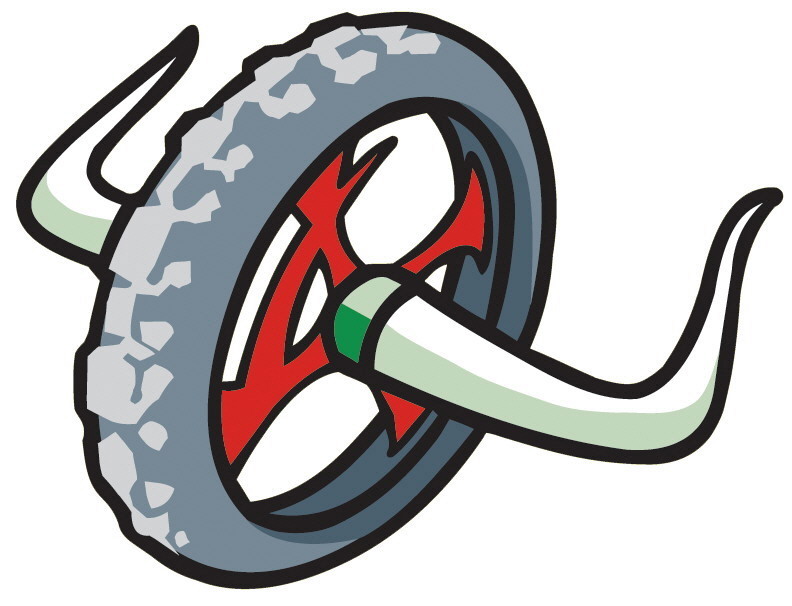Braking Forces
What happens to your bike as the brakes are applied?
go-ride.com
Introduction
If you spend any time around downhill racers you will find that a common topic of discussion is how well their bike performs on the trail. You will hear about suspension, pedaling, cornering and braking. This article discusses how applying the brakes on a bike can affect the performance of both the front and rear suspension systems.
In downhill racing every 10th of a second counts and braking is just as important for going fast as pedaling and suspension are. The better your bike handles under braking forces the longer you can wait to apply the brakes and the more confident you will be not using the brakes in scary situations. In other words; the better your braking performance, the less you have to use them, the faster you go.
Both ends of a full suspension bike are affected when the brakes are applied. We will first look at them separately and them examine how they function together.
Front Suspension
First I will cover the front suspension. All current popular DH forks are affected by what is known as "brake dive". (Note: there are a few fork designs that utilize a linkage suspension system and are not supposed to dive as the brake is applied. However, none of them are popular DH forks and most have less than 4" of travel.) As you apply the front brake the fork will compress. The braking force of the front wheel causes the riders weight to shift forward and the fork to compress.
This is not such a big deal on a 3" or 4" travel fork, but on a 7" to 9" fork it can be a real hazard. The more suspension travel your fork has the greater potential for it to dive. The more a fork dives the farther forward the rider is pushed on the bike and the greater the chance of going over the bars. At this time in suspension development some fork dive is unavoidable. However, excess fork dive is unacceptable.
Rear Suspension
Now that we have covered what happens to the front of your bike as the brakes are applied, let's take a look at the rear suspension system.
There are three basic terms used to describe how rear suspension is affected when the brakes are applied. The terms are:
Brake jack - describes a suspension that rises up when the brakes are applied. As the rear brake is applied the rear suspension expands and pushes the rider's weight forward as the suspension stiffens.
Brake Squat - describes a suspension system that lowers when the brakes are applied. As the rear brake is applied the suspension is compressed moving the riders weight backwards.
Neutral - describes a suspension system that is not affected when the brakes are applied. As the rear brake is applied the rear suspension does not rise or compress, but rather stays in the same attitude as if the brake was not being used.
What does all this mean?
You have probably already figured out that "brake jack" is a bad thing. As you apply the front brake the bike will have some fork dive, if you then have a rear suspension that jacks up all of the riders weight is going to the front of the bike and over the bars. This is not good in any situation.
XC bike (3" or 4" of travel) manufactures believe that the optimal rear suspension will stay neutral under braking forces. This is probably correct in most XC applications. With less rear suspension a bike will stop better if the rear wheel can track smoothly over the ground. A neutral braking suspension will do this best.
In DH bike applications I believe that a rear suspension that has some "brake squat" is the superior design. We know that as the front brake is applied the fork is going to dive some. This moves the rideras weight forward. But, if the rear suspension has some squat as the rear brake is applied this will help to offset the fork dive and allow the rider to stay balanced between the wheels. This is even more important as you are going down a steep hill that is already trying to move your weight forward.
As you can see some suspension designs that are optimal for XC bikes are not necessarily the best choice for DH bikes. I hope this article helps to clear up some of your suspension and braking questions.
What happens to your bike as the brakes are applied?
go-ride.com
Introduction
If you spend any time around downhill racers you will find that a common topic of discussion is how well their bike performs on the trail. You will hear about suspension, pedaling, cornering and braking. This article discusses how applying the brakes on a bike can affect the performance of both the front and rear suspension systems.
In downhill racing every 10th of a second counts and braking is just as important for going fast as pedaling and suspension are. The better your bike handles under braking forces the longer you can wait to apply the brakes and the more confident you will be not using the brakes in scary situations. In other words; the better your braking performance, the less you have to use them, the faster you go.
Both ends of a full suspension bike are affected when the brakes are applied. We will first look at them separately and them examine how they function together.
Front Suspension
First I will cover the front suspension. All current popular DH forks are affected by what is known as "brake dive". (Note: there are a few fork designs that utilize a linkage suspension system and are not supposed to dive as the brake is applied. However, none of them are popular DH forks and most have less than 4" of travel.) As you apply the front brake the fork will compress. The braking force of the front wheel causes the riders weight to shift forward and the fork to compress.
This is not such a big deal on a 3" or 4" travel fork, but on a 7" to 9" fork it can be a real hazard. The more suspension travel your fork has the greater potential for it to dive. The more a fork dives the farther forward the rider is pushed on the bike and the greater the chance of going over the bars. At this time in suspension development some fork dive is unavoidable. However, excess fork dive is unacceptable.
Rear Suspension
Now that we have covered what happens to the front of your bike as the brakes are applied, let's take a look at the rear suspension system.
There are three basic terms used to describe how rear suspension is affected when the brakes are applied. The terms are:
Brake jack - describes a suspension that rises up when the brakes are applied. As the rear brake is applied the rear suspension expands and pushes the rider's weight forward as the suspension stiffens.
Brake Squat - describes a suspension system that lowers when the brakes are applied. As the rear brake is applied the suspension is compressed moving the riders weight backwards.
Neutral - describes a suspension system that is not affected when the brakes are applied. As the rear brake is applied the rear suspension does not rise or compress, but rather stays in the same attitude as if the brake was not being used.
What does all this mean?
You have probably already figured out that "brake jack" is a bad thing. As you apply the front brake the bike will have some fork dive, if you then have a rear suspension that jacks up all of the riders weight is going to the front of the bike and over the bars. This is not good in any situation.
XC bike (3" or 4" of travel) manufactures believe that the optimal rear suspension will stay neutral under braking forces. This is probably correct in most XC applications. With less rear suspension a bike will stop better if the rear wheel can track smoothly over the ground. A neutral braking suspension will do this best.
In DH bike applications I believe that a rear suspension that has some "brake squat" is the superior design. We know that as the front brake is applied the fork is going to dive some. This moves the rideras weight forward. But, if the rear suspension has some squat as the rear brake is applied this will help to offset the fork dive and allow the rider to stay balanced between the wheels. This is even more important as you are going down a steep hill that is already trying to move your weight forward.
As you can see some suspension designs that are optimal for XC bikes are not necessarily the best choice for DH bikes. I hope this article helps to clear up some of your suspension and braking questions.






 손님
손님
댓글 달기